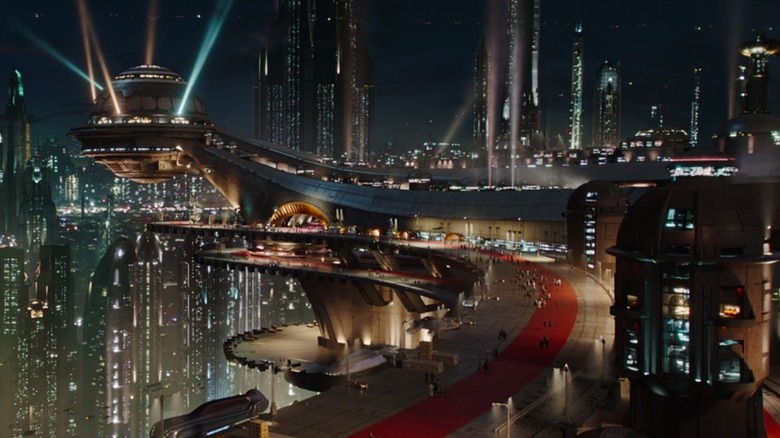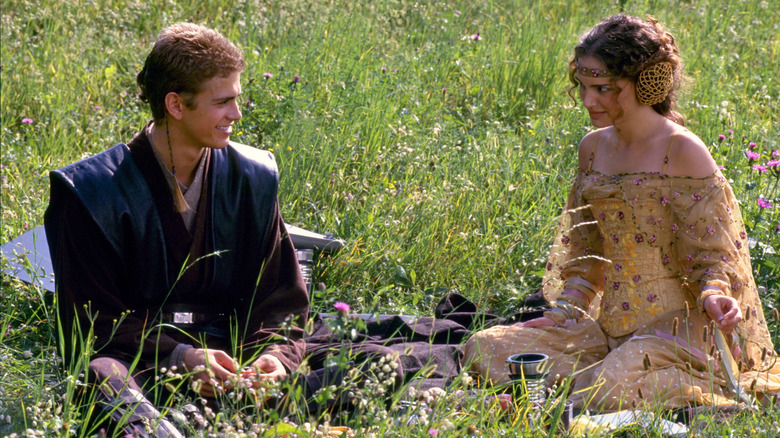Does Earth Exist In The Star Wars Universe?
The "Star Wars" universe is full of memorable planets, be it the desert-y Tatooine, the icy Hoth, the volcanic Mustafar, the endless skies of Bespin (there's an "Avatar: The Last Airbender" joke in there somewhere), or, of course, the planet-city of Coruscant. With so many worlds to keep track of, the official "Star Wars" galaxy map can be quite overwhelming — and that's before you even get to the planets that don't appear on the map, like Kamino or that new galaxy we were introduced to in "Ahsoka" season 1. The only thing we know for certain is that the "Star Wars" saga takes place long ago in a galaxy far, far away from our little corner of the universe ... or does it?
Earth is not a planet you'd think of as being anywhere near places like Narkina 5 or Moraband, but according to Disney, it's officially part of "Star Wars" canon. Of course, like many things in the franchise, this information comes from a very unlikely source. No, not the movies, nor the TV shows, novels, comic books, or even that one time a "Fortnite" event revealed a crucial piece of the plot of the Skywalker Saga. Rather, this reveal comes courtesy of the Disney Parks ride "Star Tours," which is set up as an in-universe space port, with boards listing departures and arrivals for many planets in the "Star Wars" galaxy. Apparently, one of the locations is listed as the "Earth System," which is canonically home to a refueling station for people traveling to Endor.
Granted, the existence of Earth in the "Star Wars" franchise is also implied by the presence of the Earth-visiting aliens of "E.T. the Extra-Terrestrial" in "Star Wars: Episode I — The Phantom Menace." Still, this is actual, formal confirmation.
What is the status of Earth in the Star Wars universe?
Earth, notably, was part of the Expanded Universe/Legends lore. A particularly wild issue of the "Star Wars Tales" comics even had Han Solo and Chewbacca crash-landing in the Pacific Northwest, with Han getting killed and his skeleton being discovered over a century later by Indiana Jones. (Also, Chewbacca is mistaken for Bigfoot.)
Comparatively, though, Earth plays a far bigger role in other sci-fi properties. In Isaac Asimov's "Foundation" novels, the planet's been largely forgotten in the 20,000 years since humanity reached the stars, yet it still factors into the history of robotics (and may hold the key to the "Foundation" TV show's endgame). Similarly, Earth is a huge part of the "Star Trek" franchise and often appears in its movies and TV series.
Meanwhile, Earth has also long since been abandoned and forgotten in the "Dune" franchise, and its fate has been contradicted several times. Depending on the book, it was either destroyed by war or a giant asteroid. At one point, though, the planet is even described as a giant national park, with Paul Atreides studying Earth's history after becoming Emperor in "Dune: Messiah." There, he compares himself to Genghis Khan and Adolf Hitler in terms of how many people he's killed.
So, is it better when sci-fi franchises actually include Earth as part of their worldbuilding and history? Or should they ignore it until it's casually mentioned in a theme park ride? That's difficult to say, as the "Star Wars" property is a very different beast than, say, "Foundation" or "The Expanse." Granted, "Star Wars" creator Lucas was influenced by both "Dune" and "Foundation," but his approach was more sci-fi fantasy, i.e. a fairy tale set in a faraway land rather than a story about humanity's future.

